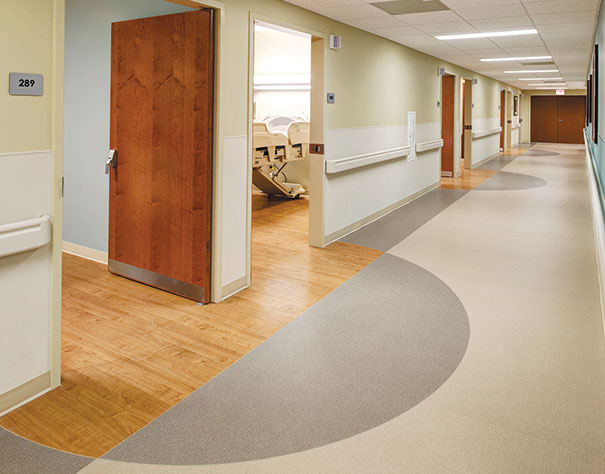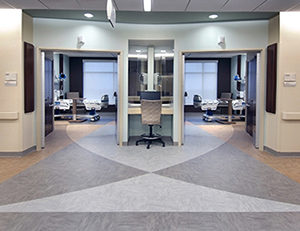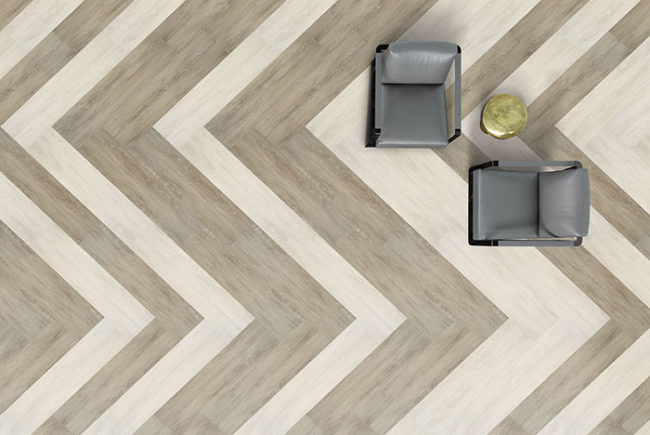 |
|
Loneco Linen flooring, from Lonseal, features an exclusive Topseal pre-applied urethane finish that protects the floor and simplifies maintenance as well as an eco-friendly product formulation that incorporates GreenAir technology for low VOCs and GreenMedic for increased microbial resistance. |
Innovative visual designs, subtle textures and rich color combinations grace the latest hard-flooring offerings that are available to hospitals. These offerings also incorporate increased durability, greater slip-resistance and easier maintenance. In addition, new seamless flooring improves cleanliness.
“In terms of cost, function, aesthetics, durability, installation and maintenance, resilient flooring usually offers the most potential,” says Brian D. Saker, product manager, commercial flooring, Armstrong World Industries, Lancaster, Pa. “The aesthetics and durability of sheet and luxury vinyl tile (LVT) make it ideal for most commercial applications, especially where design and performance are top priorities.”
Unique patterns and designs
Wayfinding patterns and designs in corridors are becoming more popular, according to Scott Slaven, marketing manager, Lonseal, Carson, Calif. “While wood looks remain extremely popular, there is growing interest in more unique patterns and designs. Lonseal recently introduced Loneco Linen, which is an abstract take on a linen design.”
No doubt, color plays an important role in a healing environment, says Lori Lagana, marketing manager, Forbo Flooring Systems, Hazleton, Pa. “Bright shades of our product, Marmoleum, cut into whimsical designs, often are selected for children’s hospitals, while woodlike patterns, such as Marmoleum Striato, help to create comforting spaces.”
Wood designs in hard flooring help to create a warm, homelike feel, experts agree. “The level of design realism in Armstrong’s heterogeneous sheet is striking. Also, resilient floors provide options for adding polish in areas where high sheen is perceived as a higher level of cleanliness, or options for low sheen to minimize glare in such spaces as long-term care facilities, where visual acuity is of special concern,” says Saker.
Aesthetics are advancing beyond traditional wood and stone visuals, with a trend toward abstract, says Natalie Jones, vice president, commercial brand development and creative product, Mannington Commercial, Calhoun, Ga. Also, hospitals want adhesives specifically designed for health care that cure faster.
“We also are seeing ‘green’ product formulations that give designers more choices,” Jones says. “Mannington recently launched Enlighten, a homogeneous sheet that has zero vinyl, 5 percent recycled materials and 4 percent renewable resources. It has a composite rubber formulation that gives comfort underfoot and reduces noise in high-traffic areas.”
Creating durable solutions
Hospitals pose many challenges to flooring manufacturers. Operating room (OR) tables, patient beds and robotic surgery equipment have increased in weight, making floor indentation a major concern. Health care facilities operate 24/7, so any replacement or maintenance work needs to be done within a tight time frame. Slip-and-fall accidents pose personal and financial hardships to hospitals as well.
To help, nora systems Inc., Salem, N.H., recently introduced norament xp, a heavy-duty flooring product designed specifically for the OR environment. It reportedly maintains durability under heavy OR tables and mobile imaging equipment and offers superior stain-resistance to chemicals. In addition, norament xp is ergonomically designed, which benefits staff who often stand for hours.
Anticipated time out of commission is a challenge the company is answering with its noraplan nTx sheet flooring, which cuts installation time by as much as 50 percent compared with standard polyvinyl chloride sheet installations. It features a pre-applied, solvent-free self-adhesive that minimizes preparation and eliminates drying time.
Infection control and the need to maintain an aseptic environment is particularly relevant to the issue of seams. “Because of infection control issues, hospitals traditionally have required seamless floors in patient rooms, but today a fair number of hospitals are opting for LVT installations there,” says David Sheehan, vice president, commercial hard surface, Mannington Commercial.
“New flooring materials also work harder to contain sound, both inside a space and between floors. Our Quiet Cover was developed with a sound absorption layer and our available underlayments provide additional protection under LVT products,” says Paul Young, director for health care markets, Shaw Contract Group, Cartersville, Ga.
The influx of hard-flooring products with a factory-applied topcoat has grown significantly, according to Jim Bistolas, health care market segment manager, nora systems Inc. “There are some risks with this trend because coatings will wear off over time and create a floor that needs to be maintained in a more traditional manner. Our flooring does not have a factory-applied coat and never requires a floor finish; however, it provides the option for a high-gloss appearance.”
Hospitals can expect to see more floating floor options — flooring that does not need to be nailed or glued to a subfloor. “Whether utilizing a grip-strip technology or a click-system, floating flooring is becoming more common in health care facilities,” says Paul Eanes, vice president of sales, Metroflor Corp., Norwalk, Conn. “It provides ease of replacement and still gives the performance values that are sought in LVT. It is important to have multiple substrates and surfaces in LVT beyond dry-back, because having only one type does not meet the challenges that the health care industry faces.”
Focus on safety
No-wax flooring options have become standard in the past few years and these finishes help to prevent slip-and-fall accidents due to increased coefficient of friction capabilities, experts agree. This is important because the cost of a slip-and-fall incident in a hospital can be significant.
All flooring manufacturers provide coefficient of friction data for their products and all should meet the OSHA standard. “There is still some confusion among building owners, however, regarding old ADA recommendations that are no longer in effect,” says Bistolas. “It is important that hospitals consult with their risk managers and look closely at the slip-resistant aspects of flooring products. This can be a huge contributor to reducing cost and improving patient outcomes.”
Mannington Commercial has designed products such as Assurance Modular with a higher coefficient of friction by dialing up the amount of aluminum oxide in the wear layer, which gives greater resistance to slips and falls. “Rubber flooring also has seen growth for this reason — comfort underfoot, prevention of slips and falls, and helping to prevent injuries,” says Sheehan.
Other introductions
Other recently introduced hard-flooring products answer these and other challenges posed by health care facilities.
Among them, Forbo Flooring Systems unveiled Marmoleum Modular, a linoleum tile collection comprising 44 colors and three coordinated sizes, including a rectangular shape. “Limitless designs can be created by mixing and matching shades, shapes and structures to create flooring solutions for hospitals. Also, the floor tile is USDA BioPreferred with antimicrobial properties that resist bacterial growth without chemical additives,” says Lagana.
Tarkett, Chagrin Falls, Ohio, recently unveiled Johnsonite Melodia 2.0 and Aria 2.0 homogeneous vinyl sheet and tile flooring, which feature a subtle, nondirectional design with colors and patterns that run throughout the sheet and tile. Featuring tone-on-tone designs, the compilation features a palette of 66 colors as well as an accent granule that adds depth to hospital spaces. Elements of the two collections can be combined in a single flooring solution.
Resilient flooring benefits hospitals because it is easy to maintain and offers durability, and new designs help to fight the cold institutional look of traditional health care spaces, according to Slaven. “Lonseal has introduced Loneco Linen, which features a robust fabric design. We pair that strength with four neutral color choices, which makes it a strong stand-alone option or one that can be paired well with wood looks.”
The Stonhard Group, Maple Shade, N.J., offers a Stonres product line that is designed for use in critical care areas of hospitals. The nonporous flooring material has been engineered to handle the increased weight of tables and beds while offering infection control features. “Stonres is poured in place; it has no welds, so it is truly seamless,” says Thomas Burns, health care market manager. “If you weld a floor or seam it in any way, it can later develop weak failure points.”
Aspecta LVT by Metroflor has a 28-mil wear layer and 3.2-mm gauge thickness. “The gauge thickness is important because thinner LVT products are more prone to unsightly telegraphing,” says Eanes. “Aspecta has achieved NSF/ANSI-332 Platinum status, which means it has passed the litmus test for abusive health care environments.”
Shaw Industries has two commercial flooring brands: Shaw Contract Group and Patcraft. Shaw Contract Group introduced Chordinates sheet vinyl at Neocon 2013, where it was awarded a Best of Neocon Silver award in the health care flooring category, says Young. The striped pattern in Chordinates allows facilities to introduce a pattern without complicated welding.
Patcraft offers a range of resilient flooring, including sheet, LVT and plank, which enables hospitals to select a mix of products that are appropriate for the spaces they are designing, according to Ridley Kinsey, director of health care markets. “In an effort to redefine the traditional wood and stone visuals within this product category, Patcraft recently launched several collections with functional patterns.”
Armstrong World Industries has introduced Natural Creations luxury vinyl tile with the I-Set installation system. “This is the answer to health care market demand for durable, quick installation flooring methods that minimize disruptions and quickly return spaces to operational status,” says Saker.
More innovations
Manufacturers are upgrading and refining their hard-flooring offerings on a regular basis. As this continues, hospital facilities managers can expect to see more flooring innovations.
is a freelance writer based in Mundelein, Ill.
For more information
For further details on the flooring products in this month’s Marketplace, contact the following vendors.
» Lonseal
» Patcraft
» Tarkett





